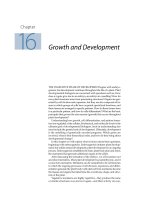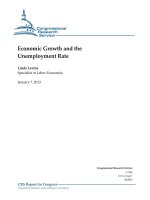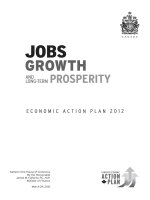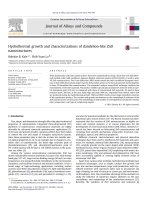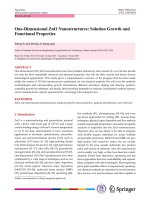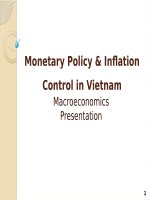Money Growth and Inflation
Bạn đang xem bản rút gọn của tài liệu. Xem và tải ngay bản đầy đủ của tài liệu tại đây (388.99 KB, 51 trang )
Money Growth and
Inflation
Chapter 28
Copyright © 2001 by Harcourt, Inc.
All rights reserved. Requests for permission to make copies of any part of the
work should be mailed to:
Permissions Department, Harcourt College Publishers,
6277 Sea Harbor Drive, Orlando, Florida 32887-6777.
Inflation
Inflation is an increase in the
overall level of prices.
Harcourt, Inc. items and derived items copyright © 2001 by Harcourt, Inc.
Inflation: Historical Aspects
Over the past sixty years, prices have
risen on average about 5 percent per
year.
Deflation, meaning decreasing average
prices, occurred in the U.S. in the
nineteenth century.
Hyperinflation refers to high rates of
inflation such as Germany experienced
in the 1920s.
Harcourt, Inc. items and derived items copyright © 2001 by Harcourt, Inc.
Inflation: Historical Aspects
In the 1970s prices rose by 7 percent
per year.
During the 1990s, prices rose at an
average rate of 2 percent per year.
Harcourt, Inc. items and derived items copyright © 2001 by Harcourt, Inc.
The Classical Theory of Inflation
The quantity theory of money is used to
explain the long-run determinants of the
price level and the inflation rate.
Inflation is an economy-wide
phenomenon that concerns the value of
the economy’s medium of exchange.
When the overall price level rises, the
value of money falls.
Harcourt, Inc. items and derived items copyright © 2001 by Harcourt, Inc.
Money Supply, Money Demand, and
Monetary Equilibrium
The money supply is a policy variable
that is controlled by the Fed.
Through instruments such as open-market
operations, the Fed directly controls the
quantity of money supplied.
Harcourt, Inc. items and derived items copyright © 2001 by Harcourt, Inc.
Money Supply, Money Demand, and
Monetary Equilibrium
Money demand has several
determinants, including interest
rates and the average level of
prices in the economy.
Harcourt, Inc. items and derived items copyright © 2001 by Harcourt, Inc.
Money Supply, Money Demand, and
Monetary Equilibrium
People hold money because it is the
medium of exchange.
The amount of money people choose to
hold depends on the prices of goods and
services.
Harcourt, Inc. items and derived items copyright © 2001 by Harcourt, Inc.
Money Supply, Money Demand, and
Monetary Equilibrium
In the long run, the overall level of
prices adjusts to the level at which
the demand for money equals the
supply.
Harcourt, Inc. items and derived items copyright © 2001 by Harcourt, Inc.
Money Supply, Money Demand, and
the Equilibrium Price Level
Value of
Money (1/P)
Price
Level (P)
Money supply
(High) 1
1 (Low)
1.33
1/2
A
1/4
(Low) 0
2
Money
demand
Quantity fixed
by the Fed
Harcourt, Inc. items and derived items copyright © 2001 by Harcourt, Inc.
Quantity of
Money
4
Equilibriu
m price
level
Equilibrium
value of money
3/4
(High)
The Effects of Monetary Injection
Value of
Money (1/P)
MS1
1. An
increase in
the money
supply...
3/4
A
(Low) 0
Money
demand
M1
1.33
2
B
1/4
1 (Low)
M2
Harcourt, Inc. items and derived items copyright © 2001 by Harcourt, Inc.
Quantity of
Money
4
3. …and
increases the
price level
2. ...decreases the
value of money ...
(High) 1
1/2
Price
Level (P)
MS2
(High)
The Quantity Theory of Money
How the price level is determined and
why it might change over time is called
the quantity theory of money.
The quantity of money available in the
economy determines the value of money.
The primary cause of inflation is the growth
in the quantity of money.
Harcourt, Inc. items and derived items copyright © 2001 by Harcourt, Inc.
The Classical Dichotomy and
Monetary Neutrality
Nominal variables are variables
measured in monetary units.
Real variables are variables
measured in physical units.
Harcourt, Inc. items and derived items copyright © 2001 by Harcourt, Inc.
The Classical Dichotomy and
Monetary Neutrality
According to Hume and others, real
economic variables do not change with
changes in the money supply.
According to the classical dichotomy,
different forces influence real and nominal
variables.
Changes in the money supply affect
nominal variables but not real variables.
Harcourt, Inc. items and derived items copyright © 2001 by Harcourt, Inc.
The Classical Dichotomy and
Monetary Neutrality
The irrelevance of monetary
changes for real variables is
called monetary neutrality.
Harcourt, Inc. items and derived items copyright © 2001 by Harcourt, Inc.
Velocity and the Quantity Equation
The velocity of money refers to
the speed at which the typical
dollar bill travels around the
economy from wallet to wallet.
Harcourt, Inc. items and derived items copyright © 2001 by Harcourt, Inc.
Velocity and the Quantity Equation
V = (P x Y)/M
Where:
V = velocity
P = the price level
Y = the quantity of output
M = the quantity of money
Harcourt, Inc. items and derived items copyright © 2001 by Harcourt, Inc.
Velocity and the Quantity Equation
Rewriting the equation gives the
quantity equation:
MxV=PxY
Harcourt, Inc. items and derived items copyright © 2001 by Harcourt, Inc.
Velocity and the Quantity Equation
The quantity equation relates the
quantity of money (M) to the
nominal value of output (P x Y).
Harcourt, Inc. items and derived items copyright © 2001 by Harcourt, Inc.
Velocity and the Quantity Equation
The quantity equation shows that an
increase in the quantity of money in an
economy must be reflected in one of three
other variables:
the price level must rise,
the quantity of output must rise, or
the velocity of money must fall.
Harcourt, Inc. items and derived items copyright © 2001 by Harcourt, Inc.
Indexes
(1960 = 100)
Nominal GDP, the Quantity of Money,
and the Velocity of Money
1,500
Nominal GDP
M2
1,000
500
Velocity
0
1960
1965
1970
1975 1980
Harcourt, Inc. items and derived items copyright © 2001 by Harcourt, Inc.
1985
1990
1995
2000
The Equilibrium Price Level, Inflation Rate,
and the Quantity Theory of Money
The velocity of money is relatively stable
over time.
When the Fed changes the quantity of
money, it causes proportionate changes
in the nominal value of output (P x Y).
Because money is neutral, money does
not affect output.
Harcourt, Inc. items and derived items copyright © 2001 by Harcourt, Inc.
The Equilibrium Price Level, Inflation Rate,
and the Quantity Theory of Money
When the Fed alters the money supply
and induces parallel changes in the
nominal value of output, these changes
are also reflected in changes in the price
level.
When the Fed increases the money
supply rapidly, the result is a high rate of
inflation.
Harcourt, Inc. items and derived items copyright © 2001 by Harcourt, Inc.
Hyperinflation
Hyperinflation is inflation that exceeds
50 percent per month.
Hyperinflation occurs in some
countries because the government
prints too much money to pay for its
spending.
Harcourt, Inc. items and derived items copyright © 2001 by Harcourt, Inc.
Money and Prices During Four
Hyperinflations
(a) Austria
(b) Hungary
Index (Jan.
1921 = 100)
Index (Jan.
1921 = 100)
100,000
Price level
100,000
Price level
10,000
Money
supply
1,000
100
10,000
Money
supply
1,000
1921
1922 1923 1924 1925
Harcourt, Inc. items and derived items copyright © 2001 by Harcourt, Inc.
100
1921
1922 1923 1924 1925


